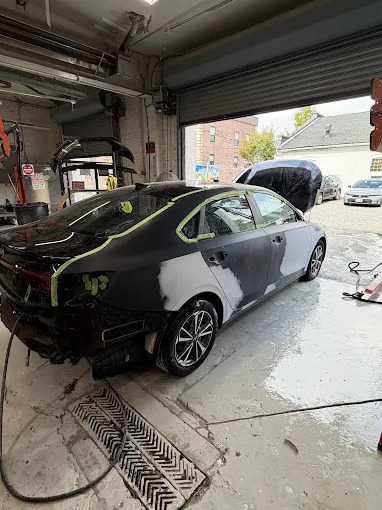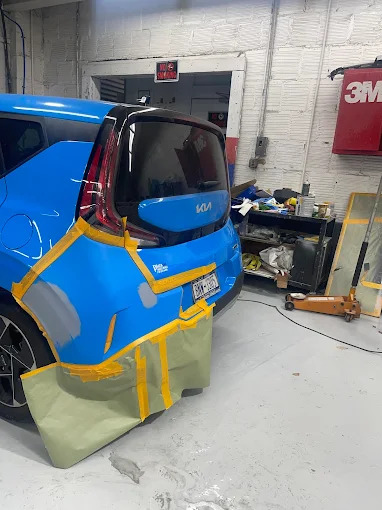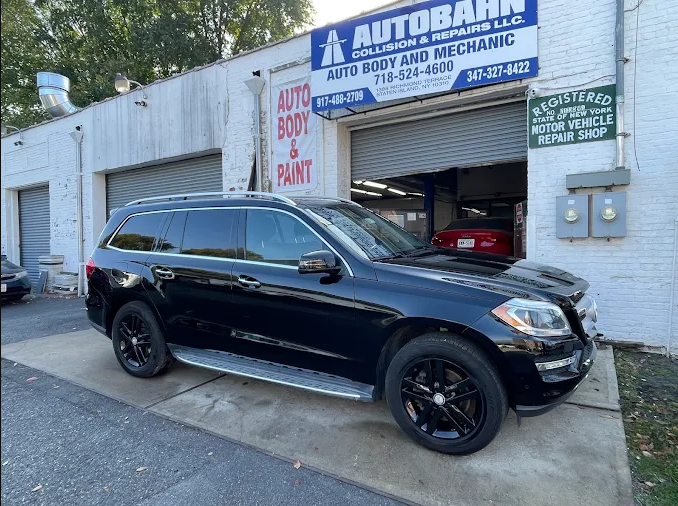Will My Insurance Cover Collision Repairs?
Collision coverage helps pay for damage to your own vehicle after a crash, no matter who caused it. You must have collision coverage added to your policy for these repairs to be covered, and you’ll pay a deductible first. Without collision coverage, repair bills come straight out of your pocket.
Defining Collision Coverage
Collision coverage pays to fix your car when it’s damaged by crashing into another vehicle or object, no matter who’s at fault. You don’t need to be worried about fault because the coverage kicks in for both single-car and multi-car accidents. It covers collisions with things like fences, poles, walls, or even potholes that mess up your suspension. Repair or replacement costs are paid up to your car’s actual cash value, but you must pay the deductible you chose. Collision coverage is optional, but nearly four out of five drivers buy it to avoid out-of-pocket repair expenses.
What Collision Coverage Includes
Collision insurance jumps in if you hit another car, get sideswiped, or even crash into a signpost. If your vehicle rolls over or gets banged up in a hit-and-run, collision coverage will pick up the bill, minus your deductible. It doesn’t matter if your accident involved one vehicle or two; your coverage can help pay for repairs. You can use any repair shop you like in most cases, but insurers sometimes guarantee work only at their trusted shops. Coverage is there whether your car is driven or parked when damaged by another driver.
Who Needs Collision Coverage
Drivers leasing or financing their cars are almost always required to carry collision coverage to protect the lender. It’s especially smart for owners of newer or high-dollar rides, who could face jaw-dropping repair bills in a serious crash. If your car’s older or worth less than your deductible, skipping collision coverage might save you money. Some drivers with a spotty record may find collision insurance costs more or requires higher deductibles. Think about the cost of your car, how much you drive, and how risky your regular commute is when deciding if you need this protection.

Collision vs Comprehensive Coverage
Collision and comprehensive are both optional, but they protect against very different problems. Collision covers crashes, rollovers, and smack-ups with objects on the road. Comprehensive jumps in for bad weather, theft, animal impacts, or vandalism that aren’t crash-related. People often buy both, since together they cover almost all possible causes of damage to your car. Comprehensive is usually cheaper, but collision fills the gaps for accidents, big and small.
Policy Requirements
No state forces you to buy collision coverage—it’s up to you, unless you lease or finance your car. If a bank or leasing company is involved, they’ll expect you to carry collision insurance the whole time you owe money on the vehicle. Dropping collision coverage is allowed once you own your car free and clear, but do the math before taking that risk. Some insurers let you “suspend” or lower coverage during seasonal use for classic cars or RVs. Always check your finance agreement or ask your agent if you’re unsure what’s needed for your specific situation.
Eligibility and Purchase
Almost any driver can add collision coverage at policy renewal, as long as the car meets underwriter standards for age and usage. Premiums are based on your car’s value, where you live, and your driving history. In high-risk cases, the deductible may be raised or coverage denied, so be upfront about accident histories. Your chosen deductible directly affects your monthly premium—a higher deductible means a lower bill. Ask your insurer for a “collision coverage quote” before you buy, so you’re not caught off guard by costs.
Finance Company Mandates
Every auto lease and most loans require you to maintain collision coverage for the life of the contract. If you let it lapse, the lender might buy force-placed insurance, which costs more and may cover less. This coverage protects the lender from losing their investment in your car. You’ll be notified in writing if your coverage falls short, often with a deadline to fix the issue. Keeping your policy current lets you choose your own coverage and avoid fees or hassles from the bank.
Coverage Limits and Deductibles
Your collision insurance pays up to the actual cash value of your car at the time of the accident, minus your deductible. There’s no preset coverage limit, only the market value of the vehicle, which can change over time. If repairs would cost more than your car is worth, the insurer will declare it a total loss and send you a check for the difference. You select a deductible amount—higher deductibles mean cheaper premiums but bigger out-of-pocket repair costs. Understanding these limits helps prevent bad surprises during the claims process.
Choosing Your Deductible
Deductible choices can run from $100 up to $2,000, depending on your comfort level and policy. Lower deductibles ease claim costs but bump up your monthly insurance bill. High deductibles do the reverse, lowering your payments but raising post-accident expenses. Consider your car’s value and your emergency savings before picking a deductible. Talk to your insurance agent about what’s best for your budget and risk tolerance—sometimes a small change saves real money.
Understanding Coverage Caps
Collision won’t pay more than the cash value of your car at the time of claim, so depreciation matters. If your repairs add up to what the car’s worth, the insurer calls it a “total loss” and pays for the value, not the fix. Salvage value might be deducted, and you can sometimes buy back your totaled car if you want. Always check current valuations for your make and model so you’re not shocked if a claim is underpaid. Coverage caps don’t change just because your car is new or custom—actual cash value rules for everyone.
Fault and Claims Process
You can file a collision claim whether you caused the accident or not—fault doesn’t matter for payout. Premiums may rise after at-fault claims, so keep that in mind when deciding if it’s worth filing. You’ll report the collision, submit documents, and meet with an adjuster who might inspect the car or review photos. Some insurers let you file claims online, making the process way less stressful. Keep your policy info handy and follow instructions from your insurer—quick action means faster payment.
Determining Fault
Fault is decided from police reports, state laws, and witness statements, and it can affect your premium going forward. Even if you’re at fault, collision repairs are covered as long as your policy is active. Sometimes fault is split, especially in multi-car crashes—your collision coverage still applies. Police officers don’t always cite fault in minor fender benders, so extra testimony helps with claim disputes. Know your state’s rules, as some “no-fault” laws make insurance payouts simpler for everyone.
Filing Your Claim
You should report accidents within 24–48 hours—delays can slow payouts or even void your claim. Claims can often be started online or by phone, and some insurers have fast-track options for minor damage. Provide your insurance card, details about the crash, and photos of damage to help things go smoothly. Your adjuster may visit the shop or direct you to a preferred network for repairs. Follow instructions and stay in touch with your claims rep—good communication leads to quicker fixes and fewer hassles.
Required Documentation
Insurers ask for a completed claim form, a police report when available, photos of the damage, and one or more repair estimates. Details about the accident’s date, location, and events help adjusters assess fault and costs. Sometimes you’ll need vehicle registration and proof of prior maintenance or repairs, too. Digital uploads and mobile apps make submission easy with most companies. Keep copies of everything—if there’s a dispute, documentation helps resolve it fast.

Repair and Total Loss
After a claim, you can usually pick any licensed repair shop, but insurer networks might offer faster service or lifetime guarantees. Adjusters inspect damage—sometimes in person, sometimes via photos—and approve the work before repairs begin. If fixing the car will cost more than it’s worth, it’s deemed a total loss, and you’re paid the value minus your deductible. Sometimes you can negotiate if you disagree with a total loss decision, especially for unique or upgraded cars. Always get a second opinion on repairs for big jobs—competing estimates can uncover hidden damage or save you money.
Repair Estimates and Appraisals
Qualified shops or adjusters write up the damage estimate, which the insurer reviews and approves for payment. You’re allowed to seek additional estimates if you think the first quote is too high or too low. Some insurers have “direct repair networks” with streamlined approval, but you can choose your own. Final price includes parts, labor, and any supplemental costs from hidden damage discovered during repairs. It’s smart to keep all estimates and check for warranty terms before repairs start.
Total Loss Settlements
When a car is totaled, insurers use market data to calculate its actual cash value and deduct your chosen deductible. Salvage value may be subtracted—sometimes you can keep the car if you’re willing to accept a smaller payout. You have the right to dispute the insurer’s valuation if you think they lowballed your settlement. Payment usually happens quickly once you agree to the terms, letting you switch vehicles and move on from the incident. Review settlement documents and ask questions before accepting—it’s easier to fix issues up front than later.
Exclusions and Limitations
Collision won’t cover theft, vandalism, animal impacts, floods, or weather-related damages—these are covered instead by comprehensive insurance. It also doesn’t reimburse for another person’s vehicle or property, nor does it cover medical bills if you’re injured in an accident. If your car is damaged while racing or driven illegally, most policies won’t pay for repairs at all. Each insurer might set unique exclusions for business use or special modifications, so read the fine print ahead of time. Always consider adding other optional coverages to fill gaps if your risk profile goes beyond basic crash repairs.
Additional Coverages
Besides collision, many insurers offer rental reimbursement coverage to cover the cost of a loaner car during repairs. Gap insurance helps if your vehicle is totaled and you owe more on a loan or lease than the car’s cash value. Roadside assistance can prove handy for towing, lockouts, or emergency jumps far from home. Lifetime repair guarantees might be included at select shops within your insurer’s network. Consider all optional protections when reviewing or updating your policy—they can save you headaches and cash if things go wrong.
Rental Reimbursement
Rental reimbursement kicks in when your car’s in the shop after a collision claim is filed. Most policies set daily maximums and total payout limits, so be aware of your coverage details. Without this add-on, you’re on your own for rental car costs while waiting for repairs. Some insurers offer direct billing, so you don’t pay upfront and chase reimbursement later. Ask about combo packages that bundle rental and other benefits for a discount.
Gap Insurance
Gap insurance pays the difference between your car’s actual cash value and the remaining balance owed on a loan or lease if your car is totaled in a collision. It’s vital for drivers who owe more on their cars than they’re worth, which often happens early in a financing contract. Without gap coverage, you could be left making payments on a car you can’t drive. Some lenders include gap coverage as a requirement, especially for new leases. Double-check your balance and consider adding gap insurance to protect your investment as long as you owe money on your vehicle.

Managing Costs and Premiums
Lots of factors affect your collision insurance premium, including your driving record, car make and model, home address, and annual mileage. Bundling policies with other coverages, like homeowners or renters, can often score you a discount. Generally, collision coverage costs more for newer and high-value cars due to higher replacement costs. Taking a higher deductible is a common strategy to reduce your monthly premium. Review your policy each year and compare quotes from other insurers to get the best rate possible.
Factors Affecting Premiums
Premiums rise quickly after accidents or speeding tickets, so safe driving saves you money in the long run. High mileage means more risk, and insurers factor this into your cost. Vehicle type matters—sports cars or SUVs may cost more to cover compared to sedans. Your credit score can also play a role; many insurers give better rates to drivers with good credit. Local laws or high-claim areas may bump up premiums even for careful drivers, so always compare prices regionally.
Tips to Lower Costs
Keeping a clean driving record is the single best way to hold down your collision coverage bill. Defensive driving courses sometimes earn discounts with your insurer. Bundling your auto policy with homeowner’s or renter’s coverage may score you a price cut. Shop around every renewal and see what deals other insurers offer for the same level of collision protection. Re-evaluate your deductible each year—adjusting upward a bit could save real bucks without sacrificing meaningful safety.
FAQs
What is collision coverage in car insurance?
Collision coverage protects your vehicle in accidents by covering repair costs regardless of who is at fault.
Is collision insurance the same as comprehensive coverage?
No, collision insurance specifically covers damage from collisions, while comprehensive insurance covers non-collision incidents such as theft, vandalism, natural disasters, and animal strikes.
How does collision insurance affect my premium?
Having collision coverage generally increases your premium, but it provides financial protection by reducing or eliminating out-of-pocket repair expenses after an accident.
Can collision insurance cover a hit-and-run incident?
Yes, collision coverage can help pay for repairs after a hit-and-run if you report the incident promptly to law enforcement and your insurer.
Do I need collision insurance on a rental car?
Coverage may extend to rental cars if your policy includes comprehensive insurance, but it’s important to confirm specifics with both your insurer and the rental agency.
What should I look for in a certified collision care center?
Choose facilities with trained, certified technicians, genuine manufacturer parts, and adherence to industry repair standards to ensure your vehicle’s safety and value are maintained.
Conclusion
Collision coverage is a vital component of auto insurance that helps cover repair or replacement costs when your vehicle is damaged in a crash or rollover. Without collision coverage, drivers are responsible for full out-of-pocket payments for any accident-related damage. By selecting a deductible that balances premium costs and potential claim expenses, policyholders can tailor their coverage to their budget and risk tolerance. Pairing collision with comprehensive insurance and optional add-ons such as rental reimbursement and gap insurance ensures broader protection against diverse risks. Regularly reviewing your policy and comparing quotes helps maintain optimal coverage at a competitive rate.
